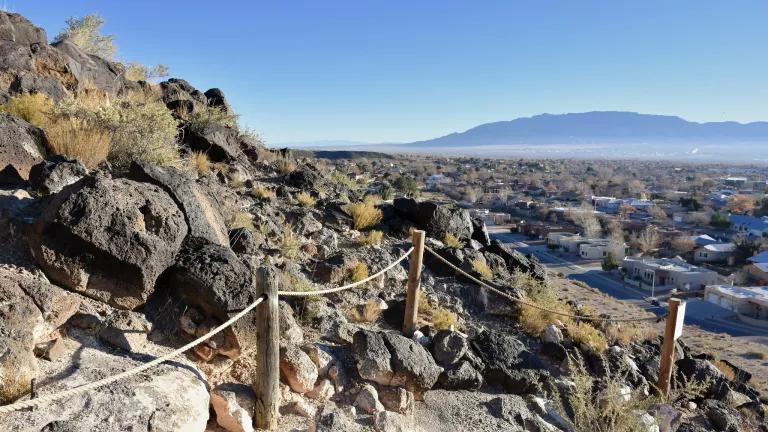California Can Make Lowly Water Heaters Mighty Climate Tools

In a groundbreaking vote, California has allocated nearly $45 million toward boosting highly efficient electric heat pump technology that can help avoid burning fossil fuels to heat our water, as well as store California’s abundant pollution-free solar energy to give us piping-hot showers when the sun isn’t shining.
The California Public Utilities Commission’s unanimous vote will jumpstart the opportunity for heat pump water heaters (HPWHs) to become a critical tool in reducing utility bills, avoiding greenhouse gases (GHG), and making our entire energy system work better. The money approved this week is part of $830 million in funding being invested over the next five years under the state’s Self Generation Incentive Program (SGIP) to encourage development of local, onsite generation and energy storage systems.
California has a clean energy storage problem because our prolific emissions-free electricity generation from large utility solar farms and rooftop panels often surpasses our energy needs at the time it’s being produced, which means more and more of this inexpensive, non-polluting resource is thrown away because we can’t stockpile it. While SGIP funding helped spur the market for rooftop solar to the point where such encouragement is no longer necessary today, we now need it to support technologies that can store the energy produced by those photovoltaic panels and other renewable energy resources. The Commission also indicated it may revisit the question of additional SGIP budget for HPWHs later.
An Important Step Forward
This CPUC vote that dedicates some of the SGIP funding toward HPWHs as energy storage is an important step forward, but it is only a piece of what’s needed to appreciably boost adoption of highly efficient heat pump water heating technology, which has significant potential to help us fight the climate crisis and reduce air pollution. As Commissioner Rechtschaffen said at the voting meeting:
This is a very efficient emerging technology that can greatly assist in reducing greenhouse gases… It can also help in managing peak load. Water can be heated and the right times and then used later. We are going to need hundreds of millions, if not billions to deal with this issue, it’s important to start transforming the market as soon as possible.
Funding from SGIP and other programs is essential to give manufacturers the certainty they need on customer demand to invest in this market and lower upfront purchase prices for heat pump water heaters.
Heat pumps can be used to heat spaces, as well as water, and also to dry clothes—replacing furnaces that burn fossil fuels and generate air pollution. Because heat pumps are highly efficient, they cut greenhouse gas emissions by 50 percent or more, even when accounting for fossil fuels still burned in power plants to generate the electricity that powers them, and the emissions and air pollution benefits will only grow as the electric grid gets cleaner.
HPWHs as Energy Storage
Heat pump water heaters are up to five times more efficient in heating water than conventional water heaters. HPWHs work like a refrigerator, only backward. Instead of pushing heat out, they use electricity to collect, concentrate, and move heat from the air around them into the water in the tank—where it can be stored hot for use hours later.
If the electricity is generated from solar panels during the day and from wind turbines overnight, heating the water is cheaper and pollution-free. It also helps avoid firing up fossil gas plants in the evenings when people return home and are more likely to want hot water, as well as turn on their air conditioners and televisions. By “shifting the load” to times when the grid is under less stress from customer energy use, the entire electric system works more efficiently—and reduces the need to keep the dirtiest power plants online.
HPWHs can be programmed to work when time-of-use electric rates are the lowest (such as the middle of the day), or utilities can send them signals to heat water at the optimum times for managing grid load—both of which cut utility bills without the customer having to do a thing. And if millions of load-shifting water heaters are used together across the state, they can make the electric grid more efficient, reducing electric rates and cutting pollution for everyone. (To learn more about how HPWHs can become virtual batteries, see this blog.)
These super-efficient and flexible water heaters already exist but are more expensive to buy and install due in large part to their low market share. In fact, heat pump appliances in general lack economies of scale in manufacturing and in installation workforce capacity. To make them accessible to all and ultimately the norm in the California market, incentives are critical. We’ve seen before how such support spurs market transformation. For example, advanced and highly efficient LED light bulbs are now replacing the old-fashioned, energy-wasting incandescent models in our homes and businesses. And solar panels have become pervasive in our state.
If California wants to meet its climate and clean energy goals, it needs to take every opportunity possible to advance all heat pump technology. Let’s make sure today’s CPUC’s vote is the beginning of a comprehensive transformation of California’s and the nation’s water and space heating markets.




